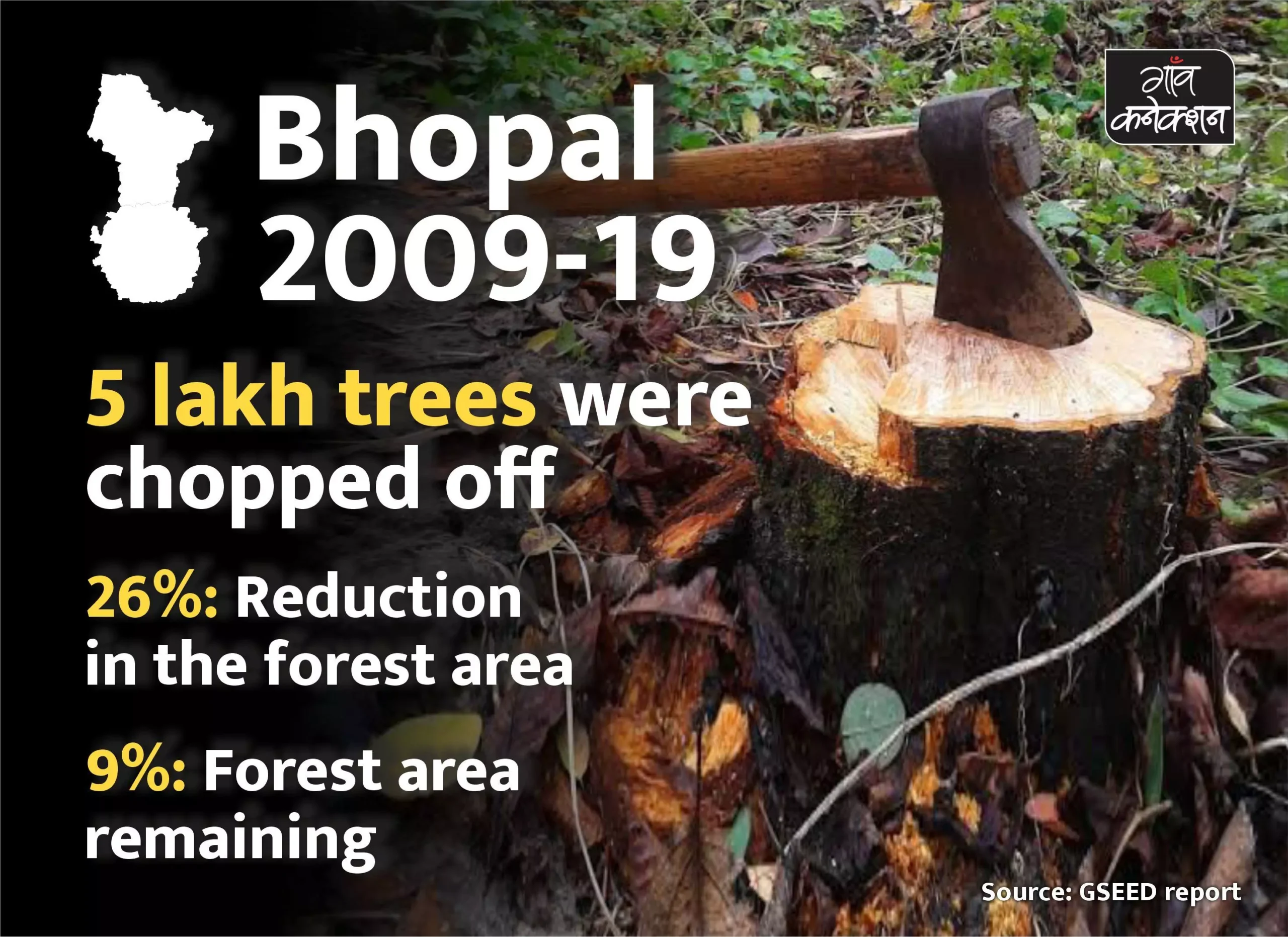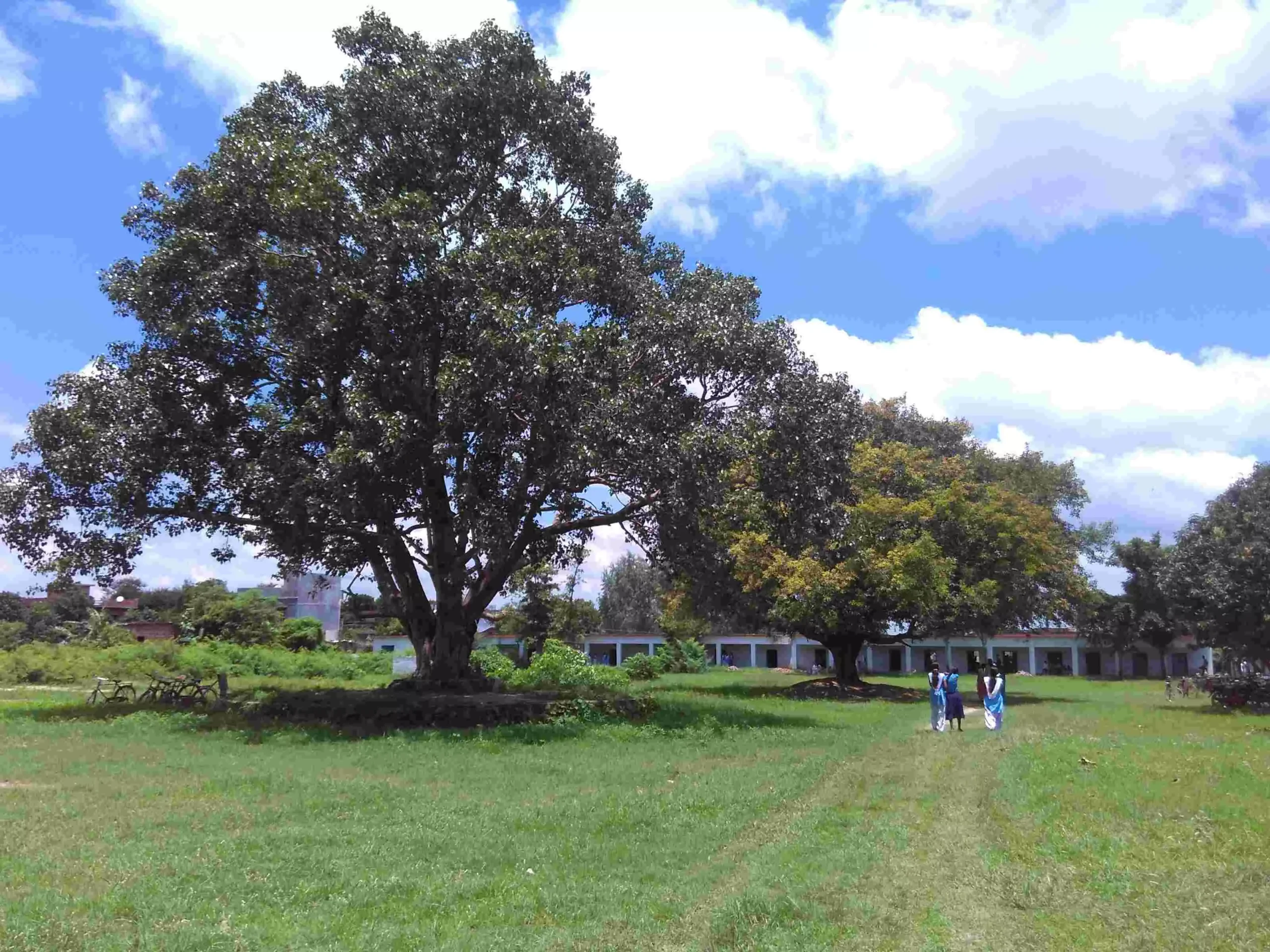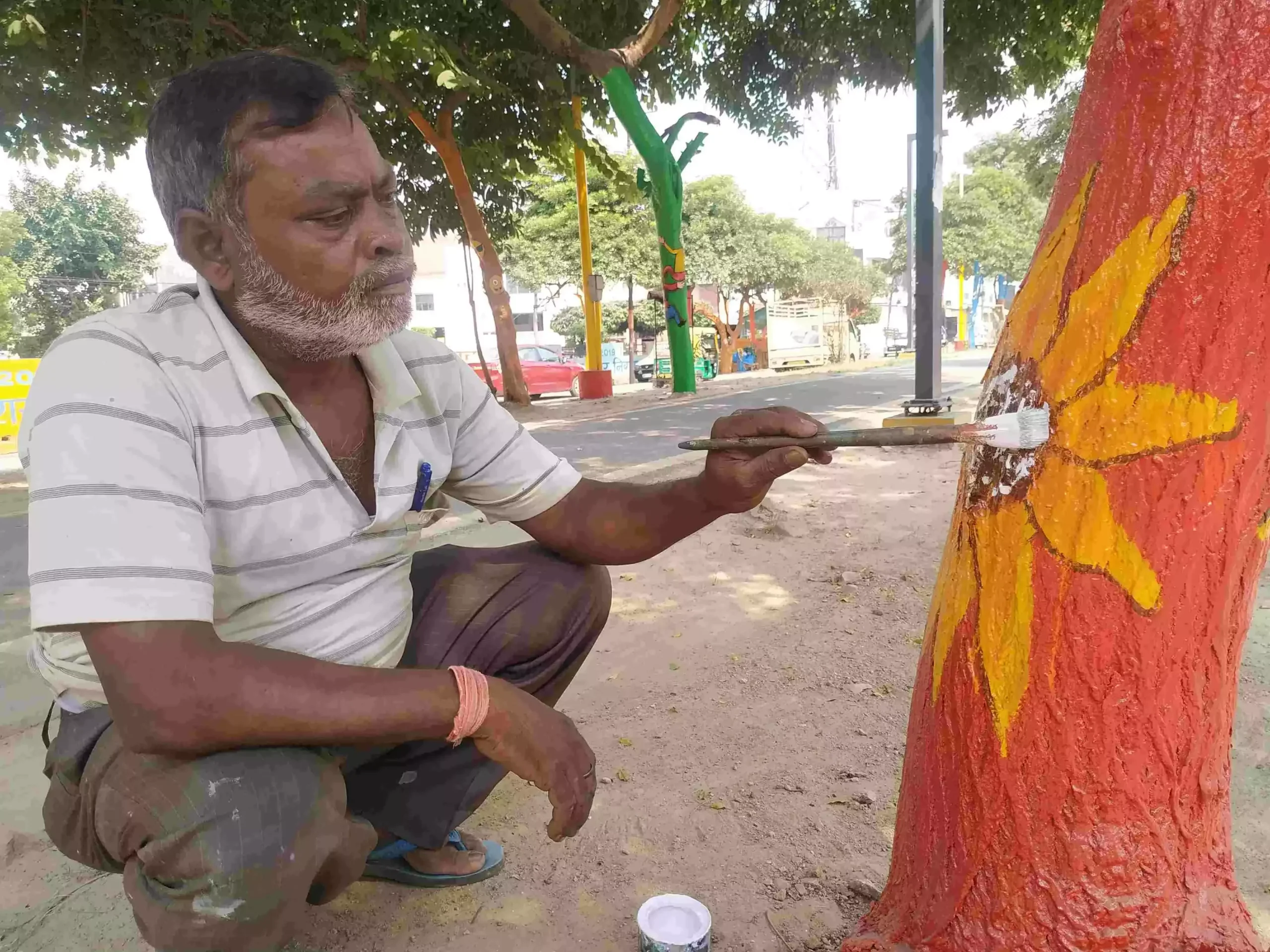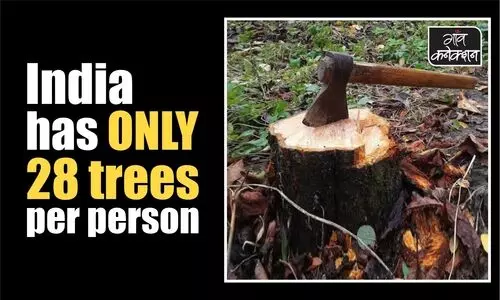Work is underway in Madhya Pradesh’s capital Bhopal to
lop off trees in order to make space for a guest house meant for Members of
Parliament. Recently, thousands of trees were chopped off in Aarey colony,
Mumbai for constructing a parking shed for the metro train. Such cases keep
surfacing from time to time whereby trees are blatantly felled to provide
extension to the cities.
This raise doubts as to whether tree cutting is the
only way to development. Can trees be kept in urban planning along with cities
or are trees non-existent in urban planning? In order to get to the core of the
issue, Gaon Connection had approached
certain experts working in the fields of urban planning, environment
conservation and afforestation.
As per Natureresearch of 2015, the Earth had about 3.04 trillion trees and India about 35
billion. If we compare India’s number with that of Brazil, China and Canada, it
seems much too small. Brazil has 301 billion, Canada 318 billion and China 139
billion trees.
If we look at the per person ratio, worldwise, there
are 422 trees per person. Brazil has 1,494, Canada 8,953 and China 102 trees
per person whereas India has only 28 trees per person. The research clearly
indicates that India doesn’t have a strong tree population.

On one side, the tree population isn’t strong and on the other side, trees are constantly being chopped off in the name of urban
development. Rakesh Diwan, a social worker in Bhopal, said: “Bhopal once had
abundant greenery, but people started cutting trees in the name of development.
As per the research undertaken by the Indian Institue of Science, Bengaluru,
Bhopal had 60% green cover in 1992 which has dwindled to 11% by 2018. If this
continues, as per the research, the green cover will be limited to a mere 4% by
2026.”
As per a study, in the past few years, about 10,000
trees have been felled for various projects, which include the ambitious
projects of the Central Business District (CBD), the BRTS Corridor and smart
city. A report of GSEED, an organization working in the field of environment, points
out that the trees are being cut at a rapid rate in Bhopal. The report states
that in the last decade (2009-19) about 5 lakh trees have been cut in Bhopal
and its adjoining area due to which Bhopal’s forest cover has shrunk to a mere
9% in 2019 from 35% in 2009. The report also informed that among the felled
trees, several were up to 50 years old.
It is not that no effort has been made to curtail
the mindless cutting of trees. Rakesh Diwan informed: “When the new government
came to power in Madhya Pradesh, a group of 15 senior citizens from Bhopal,
including me, had gone to see the chief minister Kamal Nath. We had hoped that
the new government would have a fresh outlook on the environmental issues and
this incessant felling of trees would stop but we were mistaken.”
“During our
meeting, I had told him that in the past 10-12 years, Bhopal’s temperature has
shot up by 2-3 degrees due to large scale cutting of trees. I entreated him as
our new CM to pass an order to stop felling of the forests and make for stringent
provision to its exceptions. Currently, the Municipal Corporation orders the
felling of a tree. By the time the forest department learns of the felling, the
tree is already cut and there is little accountability left. The CM replied to
this saying that the trees must be felled for the sake of development. One can
well judge the outlook of our policy-makers and only pray for the sake of waning
forests,” said Rakesh Diwan.

The outlook rued by Rakesh Diwan was also reflected in
the felling of trees in Mumbai’s Aarey Colony. The Maharashtra government had
also ordered the felling of 2,702 trees to construct the parking shed of Mumbai
Metro. While the public had stood against the order, the Union Minister for
Environment, Prakash Javadekar expressed his support towards felling of the
trees.
Citing the example of Delhi Metro, Prakash Javadekar
had said, “The Delhi Metro is today the finest in the world. People from other
countries come to see how it was installed. When its first metro station was
constructed, people opposed the felling of 20-25 trees necessary for its set
up. But for every tree felled, five trees were planted and in the past 15 years,
those trees have grown big. 271 stations were built, Delhi’s forest cover
developed, trees were increased and public transport was provided for 30 lakh
people in Delhi. So, development and environment conservation were achieved
together.”
About the claim of the Union Minister of Environment
of planting five trees in place of every tree cut, Rishabh Ranjan, a petitioner
to the Supreme Court against felling of trees in Aarey Colony, said: “You may be
aware that the order was for felling of 2,700 trees of Aarey Colony against
which planting of a mere 400 trees is being talked about. One thing must be
understood that one cannot clear up a forest and create a new one in its place.
So far, as Aarey Colony is concerned, it was previously in a no-development
zone, which meant that here no construction was permitted. However, in 2015, it
was deliberately taken off the no-development zone and what happened thereafter
is anyone’s guess. The government’s readiness can be adjudged from the fact
that by the time we could secure a stay order from the court, 2,000 trees had
already been axed, which means that the proposed number of trees were already
felled.”
Union Minister of Environment Prakash Javadekar on #AareyForest: In Delhi, 271 metro stations have been made and tree cover has also increased. This is development and preservation of nature. https://t.co/iiQn40PdZk
— ANI (@ANI) October 5, 2019
In 2017, a study of the Indian Institute of Science,
Bengaluru came to fore as per which 94% of Mumbai had been concretized in the past
four decades which means that Mumbai also has shed its green cover rapidly. The
report says that the blatant urbanization has resulted in the loss of 60 per cent
vegetation and 65 per cent water resources of Mumbai.
Rishabh Ranjan said: “The government always claims
that it plants many trees for every tree it fells, but if one looks at the
reports, this claim seems baseless. Plantation is a mere formality not
supported by any record of the trees planted, most of which any way perish.”

The Controller and Auditor General’s (CAG)’s report
also echoes similar findings. As per the CAG report, during 2014-17, the Delhi
government had targeted the plantation of 36.57 lakh plants but actually could
manage planting only 28.12 lakh plants, which means 8.45 lakh less plants were
planted. Report also mentioned that the Tree Authority instituted under the Delhi
Tree Conservation Act, 1947, had only met once during 2014-17 while it was
supposed to compulsorily call up about 12 meetings.
This report is sufficient to understand the level of
sincerity with which the plantation drives are undertaken within the country.
Commenting on these drives, Anshu Sharma, founder of SEEDS, which works in the
field of disaster-resilient infrastructures, said: “Simply planting is not
enough. We need to plant the trees best suited to the given place. But the
government machinery doesn’t seem to be working in this direction.”
Anshu Sharma said: “It is often observed that trees
are felled during construction of the roads followed by planting of eucalyptus
tree on either side of the newly- constructed road. Eucalyptus trees grow up
quickly and repay their cost easily when cut down. But overall, these trees have
caused more harm than good. They had quickly soaked up the groundwater and
their leaves being acidic harm the earth beneath.”
Eucalyptus trees are banned by the Karnataka
government. Issued in February 2017, the state government order had stated that
the trees had caused a rapid depletion of groundwater. In January 2019, the Karnatakahigh court also upheld the government’s ban on eucalyptus trees.
Anshu Sharma said: “We must look to old planning for
the plantation drives, which means that we must plant local varieties as far as
possible. But this is not happening; we are simply focusing on the greenery. The
vegetation is not just for greenery but an inherent aspect of life itself.”

Explaining the state of trees in urban planning,
Anshu Sharma said: “When the land use plan is conceptualized under urban
planning, all aspects of its utility are considered — residential, commercial,
transportation, green and open spaces and water bodies. So far as green and
open spaces are concerned, they are limited to the greening of the map. We need
to rework the definition of green spaces. Green spaces do not simply mean
greenery. We need to understand the concept of green exterior and the ecology
backing that greenery. Delhi may appear quite green to the onlookers, but is
that vegetation suited to its space — this needs to be understood.”
The India State of Forest Report (ISFR) 2017 states
that during 2015-17, India’s forest area has shown an increase of 1% (8,021 sq km).
India’s total forest cover is 7,08,273 sq km, which is 21.54% of the country’s
total geographical area. The government is endeavouring to take the forest area
up to 33%, which seems a distant dream looking at the rate with which the trees
are being cut in the race towards urbanization.
There has been some work undertaken to enhance the
forest cover or planting the trees. The government, with the support of several
organizations, is constantly undertaking the said activities. One such
organization is SayTrees, which works
towards planting trees. Its core member Durgesh Agrahari said: “So far, I have
not witnessed the level of awareness required for the trees in the country.
Firstly, we must shed the habit of viewing trees as consumable goods. Recently,
I came across news that in Lucknow certain trees were painted, which is terrible.
The small organisms living off those trees are bound to be adversely affected
by this act.”

Many trees in Gomti Nagar area of Lucknow were painted with colours for beautification.
The incidence cited by Durgesh Agrahari had taken
place this October in Lucknow, Uttar Pradesh’s capital. The Lucknow Municipal
Corporation’s vice-chairperson, Arun Kumar Tiwari had flagged off a pilot
project of painting the trees in the capital’s posh locality of Gomti Nagar.
For the project, 115 metres of area was marked, where about 100 trees were to be
painted with synthetic colours. When media published about the project, the forest
department stalled the project.
The then vice-chairman Arun Kumar Tiwari, at that
time, had informed Gaon Connection: “Last
time, our ward stood third in cleanliness while Lucknow stood first. This time,
we thought contesting for the top spot would be good. We talked to the
officials and came up with this plan. Now we will try and enforce this model
across entire Lucknow.”
Durgesh Agrahari said: “Trees are a crucial aspect
of our lives. We all know it, but choose to overlook the fact since we do not
gain directly from the trees. So, there is a need for awareness campaigns,
especially in cities, towards saving the trees. Only when people begin to understand,
there will be a change. This effort should not be singular but sustained. The
school-going children must be involved in the plantation drives so that they
understand the value of trees. Since 2015, we have been able to plant about 2.5
lakh trees, a feat which we could achieve only by everyone’s participation.”
Read Also: “What’s the point of development when our kids are going to die because of pollution?”
Read Also: Paint trees with synthetic colours … that’s their idea of beautification




















